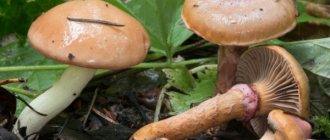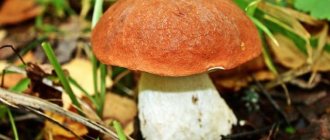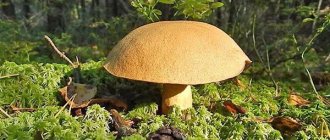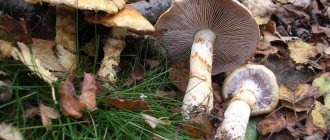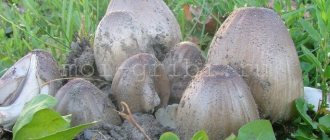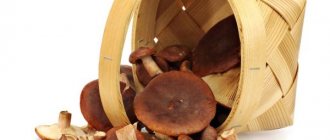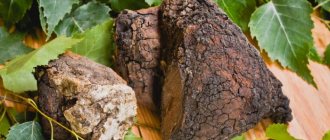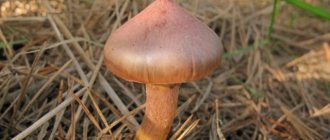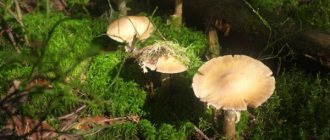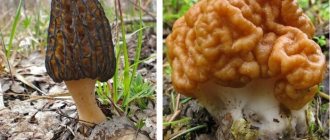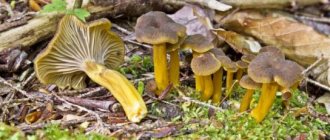Defeated enemies
But there is another interpretation of what it means to dream that only wormy or poisonous mushrooms are found in the forest.
According to dream interpreter Hasse, this is a harbinger that enemies who are plotting something evil against you will make a fatal mistake. And you, if you are not at a loss, can safely use their mistake for your own purposes with considerable, by the way, benefit. While you were sleeping, you snacked on fly agaric mushrooms and worms, but are you in a great mood and full of energy? An excellent sign indicating that spiteful critics and enemies will not achieve their goals in reality, but will also involuntarily contribute to your success and prosperity.
- Mushrooms - interpretation of sleep
- Worms - interpretation
- Forest - interpretation
- Garden - interpretation
- Earth - interpretation
How to identify a wormy porcini mushroom
Mushrooms brought from the forest must be cooked immediately. Otherwise, after a few hours the entire crop will be inedible. All forest finds must be thoroughly washed, sorted and cleaned. Immediately throw away old, very large and weak mushrooms. After cooking, they will become soft, lose all taste, and their consumption can also result in poisoning.
While the mushrooms are being sorted, their “authenticity” is checked once again. Again, only visually. All the myths that silverware darkens when it comes into contact with poisonous mushrooms are not true. You should not believe that poisonous mushrooms are not wormy; when cleaning, it will still not be possible to identify them by this sign.
When everything is checked, the mushrooms are cut and begin to cook. And here there is another secret, how to determine whether a mushroom is poisonous or not, already during the cooking process. Along with the forest harvest, the bulb is immediately lowered. If a poisonous mushroom does end up in the pan, the onion will take on a bluish tint. Then you will have to part with undercooked soup.
Worms in fungal organisms are the larvae of any forest midges. Insects love to lay eggs on the body of forest beauties, because moisture, food and shade are ideal conditions for their reproduction. Moreover, their relationship is mutually beneficial. Worms help spread spores in the soil, thereby increasing the mycelium and helping to increase the yield in the future.
Many people wonder whether poisonous mushrooms are wormy. There is an opinion that no. This is partly true. For example, worms are not found in toadstool or fly agaric. However, the toxicity of poisonous individuals varies, and therefore the likelihood of them being affected by fungal worms exists.
There are also edible, tasty and very healthy species that are virtually never wormy. These are chanterelles, they are fried even without preliminary heat treatment, they have a rich vitamin and mineral composition, are a natural antibiotic and, despite this, flies and mosquitoes avoid them.
Worms most often affect white worms, boletus, saffron milk caps, russula, boletus, and milk mushrooms. Worms are much less common in honey mushrooms, aspen mushrooms, gray and purple rows, and oyster mushrooms. Only one conclusion can be drawn: there are fewer of them in autumn mushrooms than in summer ones. Apparently, cool temperatures are uncomfortable for flies and mosquitoes for breeding purposes.
Regarding the wormy gifts of the forest, expert opinions differ. Some people, purely for psychological reasons, simply cannot afford to put a mushroom with worms in their basket. But those for whom collecting is a business do not disdain worms, especially if you dry them, nothing will be noticeable at all.
In some cases, wormy mushrooms should not be eaten:
- as a rule, worms are more likely to attack old and overgrown organisms, which are doubly dangerous to collect;
- inedible does not mean poisonous. They may be bitter and tasteless to humans, but not to the worm. Therefore, it is strictly forbidden to collect unfamiliar wormy mushrooms;
- worm to worm - discord, large wireworms, click beetle larvae can damage the stem without affecting the cap. Many small worms make the fruit body unsuitable for consumption.
The presence of worms in mushrooms does not make them inedible. We can say that everything depends on their quantity. It is difficult to refuse and leave the beauties - white or boletus - in the forest just because they have small wormholes on their legs. Usually mushroom pickers check the trophy for worms right there in the forest.
If small wormholes do not cause disgust and do not spoil the appetite, they can be eaten. There are several proven methods for clearing parasites from mushrooms:
- Upon arrival home, the mushrooms should be sorted out, trimmed, cleared of debris, large ones should be cut into four parts and filled with saline solution (a tablespoon of salt per 1 liter of water). Soak in this brine for 2 hours, then rinse well and boil;
- Mushrooms intended for drying should not be laid out on a baking sheet, but on a wire rack. As they dry, all the larvae will spill out;
- in the first minutes of boiling the mushroom broth, the remaining worms rise to the top along with the foam. Reduce the heat and carefully skim off this foam.
In a separate category of worms, it is worth highlighting the larvae of moths, which love dried mushrooms and are already infested at home if they are stored incorrectly. A proven method of combating it is to sprinkle dry fungi with ground black pepper. Before cooking, they will still be washed, but moths will not touch them.
In the forest, when collecting, there is an unspoken rule: if for some reason (maybe it is too old, rotten or wormy) a mushroom does not suit you, you do not need to throw it away. The cap should be carefully placed with the spores facing down. Perhaps this will be the formation of a new mycelium, and you will contribute to the increase in the population of edible mushrooms. For the same reasons, you should never kick fly agarics and toadstools, promoting their reproduction.
Where to look for the Psilocybe semilanceolate mushroom: places of growthRecipes for preparing and pickling honey mushrooms for the winter
Determining whether a boletus is wormy or not is quite simple. You just need to look at its cut location. The presence of parasites will be indicated by numerous round holes, pits and passages, which are clearly visible on the cut.
Depending on the number of holes, irregularities, passages, etc., the degree of damage to the boletus by worms is determined. If it is replete with a large number of holes and “burrows”, it is left in the forest. Typically, older fruiting bodies are too wormy, although there are exceptions.
In dry and sunny weather, fungus flies and mosquitoes are more active and lay many eggs. On the contrary, if the weather is cloudy and rainy, the number of worm-bearing boletuses is significantly less.
After sorting and removing the worms, boletus can be used for all the same purposes as regular ones. There are quite a lot of recipes for preparing various dishes with these mushrooms. Here are some names of dishes that can be prepared from them.
- Zrazy with egg and mushrooms.
- Butter fried in sour cream.
- Baked potatoes with mushrooms.
- Mushroom soup.
- Butter stewed with potatoes.
- Butter fried with onions.
- Butter with chicken.
These mushrooms are good as an independent dish; they are often stewed or fried with potatoes in various variations, and used as a filling for pies. You can use them to prepare numerous mushroom appetizers, sauce, and mushroom caviar. You can also use boletus to prepare mushroom soup. However, in this case, it is better to strain the broth, since a worm that accidentally floats up in the plate can suppress your appetite for a long time.
After removing the worms, the boletus can be dried on a wire rack or in the oven. When dried, these mushrooms can be stored for up to one and a half years. Boiled boletus is often frozen and stored as a semi-finished product, later used for frying, stewing or preparing mushroom soup.
Important! Mushrooms are quite heavy food, so their consumption is contraindicated for children under 10 years of age.
It is better for beginners to go to the forest in the company of experienced mushroom pickers. If you have the slightest doubt, they will provide competent and comprehensive advice based on their extensive experience. At the same time, they will show you mushroom spots and teach you how to navigate correctly.
We invite you to read: Watermelon in central Russia: secrets of cultivation
When going on a “silent hunt”, you need to choose the right clothes. It should be loose and well protected from insect bites. Indispensable attributes are a hat and closed shoes. If there are ticks in the forest, trousers are tucked into boots, and a jacket into trousers. These dangerous insects always crawl from bottom to top. It's a good idea to tie a scarf.
Then the places that ticks love so much will become inaccessible:
- groin area;
- armpits;
- depressions behind the ears;
- neck.
A wicker basket made from pine shingles, wicker, or birch bark is the best container for harvesting because it breathes. An experienced mushroom picker will never collect boletus and boletus mushrooms in a plastic bucket or plastic bag.
Many beginners think: the further into the forest, the more gifts of the forest, and they are mistaken. In dense areas, redheads, boletuses, and boletus grow reluctantly. There are much more of them in places with sparse vegetation or border strips: on the edges, along the banks of streams and lakes, along the edges of ravines, along forest paths, in clearings.
Representatives of the mushroom kingdom have one peculiarity: they accumulate all the harmful substances contained in the soil. Therefore, experts do not recommend collecting forest trophies closer than 500 meters from country roads and 1000 meters from federal highways. Otherwise, combustion products of gasoline and diesel fuel may enter the body: organic compounds of lead, oxides of nitrogen, sulfur, carbon, and this is unsafe for health.
You should also not collect forest gifts if nearby:
- Railway;
- oil storage;
- agricultural grounds;
- nuclear power plant;
- factory or plant.
You cannot buy honey mushrooms, milk mushrooms, and white mushrooms from private individuals standing along the roads. It is unknown where they collected. In addition, among the good specimens, the inedible one can easily get lost.
Many dangerous representatives of the mushroom kingdom have similar symptoms of poisoning, but symptoms can be observed at different times - from several hours to a day and a half.
They appear as follows:
- temperature increase;
- drop in blood pressure;
- uncontrollable vomiting;
- diarrhea;
- convulsions;
- in case of fly agaric poisoning - hallucinations;
- pain in the stomach;
- sometimes loss of consciousness.
At the first signs of intoxication, you must urgently call an ambulance.
Before the doctors arrive, the victim is prescribed a number of procedures:
- Gastric lavage. The patient should drink a weak solution of potassium permanganate. Then, pressing with your fingers on the root of the tongue induces vomiting. (Repeat step 1 3-5 times).
- If there is no diarrhea, you need to drink a saline solution or a gentle laxative.
- Take several tablets (1 piece per 20 kg of weight) of activated carbon to remove toxins from the body.
- To restore water balance, give the patient small drinks in small portions so as not to provoke vomiting.
- Place 2 warm heating pads on your legs and stomach.
Is it possible to eat wormy mushrooms?
Regarding the wormy gifts of the forest, expert opinions differ. Some people, purely for psychological reasons, simply cannot afford to put a mushroom with worms in their basket. But those for whom collecting is a business do not disdain worms, especially if you dry them, nothing will be noticeable at all.
In some cases, wormy mushrooms should not be eaten:
- as a rule, worms are more likely to attack old and overgrown organisms, which are doubly dangerous to collect;
- inedible does not mean poisonous. They may be bitter and tasteless to humans, but not to the worm. Therefore, it is strictly forbidden to collect unfamiliar wormy mushrooms;
- worm to worm - discord, large wireworms, click beetle larvae can damage the stem without affecting the cap. Many small worms make the fruit body unsuitable for consumption.
The presence of worms in mushrooms does not make them inedible. We can say that everything depends on their quantity. It is difficult to refuse and leave the beauties - white or boletus - in the forest just because they have small wormholes on their legs. Usually mushroom pickers check the trophy for worms right there in the forest. Something needs to be thrown away, something needs to be cut off. If infected specimens are kept in the same basket with clean ones for several hours, the worms will quickly crawl onto them, and there will be no good ones left.
How to get rid of worms in mushrooms: different technologies
The classification of fungal organisms into edible, inedible and poisonous categories undergoes periodic amendments. Everything is clear with the poisonous ones, their list is more stable, but the line between edible and inedible is very precarious. Some species that are not eaten in some areas are considered almost a delicacy in others. As they say: “You just have to know how to cook them.” These include volushki, russula, valui and some types of rows.
You can get poisoned even from absolutely edible mushrooms if you neglect the collection rules.
It is known that under no circumstances should you pick mushrooms near highways or near industrial enterprises. But at what distance from a factory pipe or toxic drains they can be torn is not very clear. What is under the layer of moss and soil is also unknown. And is it possible to collect overgrown and wormy mushrooms?
Fungal parasites are nothing more than the larvae of mosquitoes and flies that develop into adult insects by eating the pulp of the fruit. However, such parasitism does not threaten the mycelium in any way, and even, on the contrary, improves productivity due to the worms moving spores from under the cap directly into the ground.
Most mushrooms are affected by worms, even if their appearance does not always indicate their presence.
There is an opinion that poisonous mushrooms are not wormy, but this is nothing more than just a myth. Even the most poisonous specimens can be affected by parasites. Moreover, most poisonous species act as food not only for worms, but also for snails and slugs.
The likelihood of stumbling upon a fly agaric or a toadstool infected with larvae is quite high, because their poison does not pose any threat to these insects, since their metabolism is significantly different from that of humans. In addition, some inedible fruits emit an aroma that only attracts insects.
Checking the fruit for safety for the body, relying on damage by worms, is not only unreasonable, but also extremely dangerous. For example, edible chanterelles are never attacked by worms, because their flesh contains chitinmannose, a toxic substance for insects, unlike the same fly agaric.
A wormy fruit is not dangerous and, as a rule, there is no need to get rid of it, but when harvesting such a “harvest” you should rely on your own feelings and sense of disgust. After all, not everyone is able to eat a product affected by living organisms.
Everyone, of course, knows the division of the most familiar cap mushrooms into tubular and lamellar. In order to determine this, just look at the underside of the cap. If the layer in which the spores ripen (hymenophore) is similar to a sponge and consists of many small tubes, the mushroom is tubular.
If the hymenophore is made of plates, it is a plate mushroom. With some reservations, chanterelles can also be classified as lamellar.
What am I talking about? And to the fact that all the most dangerous poisonous mushrooms in our forests belong to lamellar mushrooms. But among the tubular ones there are none poisonous at all.
True, there is a known (even from school textbooks) hardly fatally poisonous mushroom with the terrible name “satanic” (Boletus satanus).
But mycologists have long argued that the toxicity of the satanic mushroom is simply a myth. Most likely, people in Europe tried to eat the mushroom raw, in salads. But even quite natural digestive problems with this method of consumption did not lead to deaths. In addition, the mushroom is quite rare, and its appearance is peculiar enough that it could be confused with some other one.
So, tubular cap mushrooms, boiled or fried, can be eaten without fear of poisoning. These are the famous white mushrooms, and boletus with aspen mushrooms, and boletus mushrooms, and Polish mushrooms, and moss mushrooms... True, occasionally among the tubular ones you come across inedible ones - due to the bitter taste and hardness. For example, gall mushroom is bitter and tasteless. But not poisonous!
But with lamellar mushrooms you should be more careful. Firstly, all our poisonous mushrooms are lamellar. Secondly, most of them contain bitter milky juice and are not suitable for fresh consumption. Most often, they should be soaked for several days and then salted. Trying to fry fresh mushrooms or milk mushrooms will not lead to anything good.
Only saffron milk cap and chanterelle (and that lamellar one is only conditional - after all, it has not plates, but folds) can be used immediately after collection.
The people have several signs for identifying poisonous individuals, and many of them are erroneous. For example:
- It is believed that edible specimens are pleasant to the taste. Not true - fly agaric mushrooms are also tasty.
- Young fungi are safe; toxicity comes with age. This is not true, especially regarding the toadstool - it is deadly at any age.
- Poisonous mushrooms smell unpleasant. Nothing like this. Many poisonous and conditionally edible specimens have a pleasant aroma, while many have no odor at all. Representatives of the inedible category usually have an unpleasant odor.
- There is a widespread belief that poisonous mushrooms are not wormy - they are supposedly not to the taste of insects. Taking mushrooms that have been eaten away by worms and nibbled by snails into a basket, mushroom pickers think that these mushrooms are definitely edible. In fact, insects can live in any mushroom.
- Many are sure that alcohol neutralizes poison. Not true again. This misconception is especially dangerous - alcohol, on the contrary, contributes to the intoxication of the body with mushroom poison. If you drink poisonous mushrooms with alcohol, the likelihood of death increases.
- The opinion about the benefits of boiling mushrooms is also erroneous - boiling does not get rid of all poisons. There are toxins that are neutralized after boiling, and there are others that are resistant to high temperatures.
We suggest you read: How to grow mushrooms in the garden
When going on a “silent hunt”, it is important to know the exact description of edible mushrooms. If the specimen does not correspond to the description in any way, it is better to refuse it.
The first and most famous method is to soak the mushrooms in salted water. The procedure takes several tens of minutes. When the larvae leave the holes, the mushrooms are placed in a colander and washed. Despite its simplicity, during practical experiments it was found that some nuances should be taken into account.
The next method of expelling larvae from shelters is to raise the temperature. It was observed that in the initial stage of the drying process the desired result can be obtained. For this procedure, you can use a standard oven. If the mushrooms are not intended to be dried, then the cooking time must be limited. It is also useful for preliminary removal of excess moisture before freezing mushrooms.
2006-2016 — Production, sale and delivery of oyster mushrooms wholesale throughout Russia
Since the beginning, news releases have been full of reports of people dying from mushroom poisoning. But there are no fewer fans. An experienced mushroom picker knows his business, but we advise beginners to learn how to determine which tubular mushrooms are poisonous and edible?
This name appeared because the lower part of the mushroom cap consists of a tubular layer. They are divided into types:
- edible;
- inedible;
- poisonous.
The most popular:
- White mushroom or boletus. You can find it in spruce forests, pine forests, and mixed forests. In young mushrooms the cap is strongly convex, in old ones it is almost flat and colored brown. Its lower part consists of a tubular layer, which can change color from white to yellowish-greenish. The leg is brown in color, reaches 10–15 cm in length and 7–8 cm in width, is white inside, has a pleasant aroma and taste. Mushrooms grow quickly. Large specimens are found. A well-known record is a six-kilogram boletus.
- Butter. Their cap is covered with mucus. It has a conical shape and brownish-brown color. In young people, the lower part of the cap is covered with skin; with age, it tears, and a ring remains on the stem. You can find boletus in the pine forest. Collection time June – September. They are marinated, fried, boiled.
- Moss fly. Painted yellow-brown. Grows in a pine forest. Collection period July – October. With age, the hat changes shape from convex to flat. The diameter is about 5 cm. The inside of the mushroom is yellowish, after a while it turns blue.
- Boletus. The hat is red. Grows up to 20 cm in diameter. The height of the mushroom is 18–20 cm. Weight is up to 2 kg. Found under aspen, pine and birch trees. The pulp is white.
- Polish mushroom. Rarely seen. Similar in appearance to boletus. The hat is roundish and dark brown. Grows in old pine forests. It has an original taste.
- Boletus. Grows in birch forests. Looks like a boletus. It has scales painted black. The cap is strongly convex, covered with skin underneath, which is difficult to separate from the pulp. It is painted gray. The mushroom quickly deteriorates and worms grow in it. Therefore, young mushrooms are collected for pickling, pickling, frying, and boiling. Seasonings are often prepared from it.
Outwardly they resemble edible ones. That’s why they are called “doubles”. These mushrooms are not poisonous, but have a bad smell and a bitter taste. Once in the basket, they will ruin both food and health. The most famous:
- Bile mushrooms. They grow in pine forests on sandy soil. Externally they are very similar to porcini mushrooms. Brown convex hat. Pay attention to the inside - it is dirty pink, this will help you distinguish the mushrooms.
- Satanic mushroom. So are tube mushrooms poisonous? Yes. The most famous is this representative of the family. Consuming it leads to poisoning. This mushroom looks like a boletus or boletus mushroom. True, his hat is dirty grayish. To avoid mistakes, pay attention to the underside of the cap. In the satanic mushroom it is colored red, this is a sign of a poisonous mushroom. When cooking, we advise you to pay attention to how the mushrooms turn blue. Edible ones are fast, but poisonous ones are much slower.
How to identify poisonous mushrooms - the most reliable method
People have many ways to test mushrooms for toxicity, but all of them are unreliable and are designed to detect a single poison. Accurate identification is possible only on the basis of characteristic features by which deadly types of mushrooms can be accurately identified. If you come across a dubious specimen whose identification you doubt, proceed as follows:
- Look at the inside of the cap to determine whether the unidentified specimen is a lamellar or tubular mushroom. All the most poisonous mushrooms are lamellar. For example, fly agarics and toadstools. Therefore, be especially wary of such mushrooms.
- Look carefully at the bottom of the mushroom. Fly agarics and toadstools of all varieties have an ovoid thickening in the lower part of the leg.
- Look to see if there is a collar ring on the leg. It is located approximately in the middle - a little closer to the cap. If the mushroom has a “skirt,” throw it away as soon as possible.
The video introduces viewers to the most dangerous mushrooms for humans. Find out how to identify them and how they affect the body:
Treatment
If the doctor determines that the patient has parasites, therapy with specific agents should be started immediately. Preference is given to complex treatment to combine the positive properties of several drugs.
So, first they use medications that weaken worms, these can be drugs based on Levamisole (Dekaris). A few days later, the person is prescribed another anthelmintic, this can be Nemozol or Vermox.
Parasites in the body are paralyzed after the use of special agents. This effect eventually leads to the death of the worms. The doctor prescribes drugs at his own discretion, based on the existing clinical picture. The list of medications that are most often used to treat helminthiasis is as follows:
- Biltricide with the active substance praziquantel. The drug causes muscle stiffness and the parasites are paralyzed,
- Vormil and Nemozol stimulate irreversible biochemical processes in helminths,
- Decaris or Levamisole - the drug disrupts the energy exchange processes of parasites,
- Helmintox and Nemocid have a paralyzing effect,
- Vermox or Mebendazole eliminates cellular synthesis and energy metabolism of worms.
Additional treatment is also used:
- Sorbents: Enterosgel, activated carbon. Medicines remove toxic waste products of worms that are in the body,
- Symptomatic remedies: painkillers and antiallergics. Necessary to eliminate associated symptoms,
- The use of probiotics is indicated to restore intestinal microflora.
These drugs are well tolerated by people of any age. They are also recommended for preventive purposes. Lactation and pregnancy are special indications for therapy exclusively under medical supervision.
Attention should be paid to eliminating the possibility of re-infection. In the human body, worms and eggs that are present will constantly come out, so underwear and bed linen must be constantly changed.
Types of fungi
The interpretation of the dream largely depends on what kind of mushrooms were with the worms. Here's what some of them dream about:
- saw honey mushrooms - to loss of money;
- dreamed of chanterelles - to troubles and burdensome worries;
- saw the champignons - to self-deception and grief because of this;
- I saw a boletus - there will be obstacles on the way;
- saw oyster mushrooms - troubles await you at work;
- dreamed of boletus - the work into which you have invested a lot of effort will be in vain;
- whites saw - to health problems;
- toadstools or fly agarics appeared in dreams - to victory over spiteful critics.
We invite you to read: Caring for gooseberries in open ground in spring and autumn, after harvest
Chanterelle: an unusually healing mushroom
Chanterelles appear in mid-June and delight mushroom pickers until the end of October. They live in families. If you come across such a “family”, then from one clearing you can collect a decent basket. The ubiquitous chanterelles are found either in pine or mixed forests. They love places under old birch trees, all sorts of slopes, hillocks, and soil disturbances.
Worms are not afraid to eat “doubles” of chanterelles. Why are chanterelles not wormy? Maybe the worms don't eat the mushroom because it's poisonous? Not at all. This is a far-fetched fear. Even in the toadstool, which is dangerous to humans, the fungus gnat larvae feel great.
Humans, insects, and parasites have different metabolic mechanisms. The substances contained in mushrooms, which are poisonous to humans, are not involved in the metabolic processes of protozoa. Conversely, chanterelle D-mannose is lethal to helminths and absolutely harmless to humans. What is good for a person is death for a helminth.
Moreover, mushrooms can be treated. Neither plants nor minerals have become such a sensation as mushrooms. In Japan, mushroom treatment (fungotherapy) has been known since ancient times. Now it is becoming popular in Europe and Russia. This science is called the future of modern pharmacology. And it turned out that most medicinal mushrooms grow in Russia.
There is only one reason for the fact that chanterelles are never wormy - D-mannose in their composition. This substance allows us to talk about chanterelles as a medicine. But for chanterelles to be a medicine, they must be consumed dry or fresh. Without heat treatment and without treatment with caustic substances. Mannose is capricious.
According to the WHO (World Health Organization), eighty percent of diseases are caused by parasites and the consequences of their activity on the body. This means asthma, diabetes and many others. That is why chanterelles, which are non-wormy mushrooms, are considered a universal remedy, a panacea for most diseases.
Another important substance in chanterelles is ergosterol, which is able to cleanse and restore the liver.
Two more substances were found in chanterelles: polysaccharide K-10 and trametonolinic acid. They act on the hepatitis virus. Effective for hemangioma and fatty liver degeneration.
Chanterelles are used to correct vision and treat night blindness. They prevent aging by being a strong antioxidant and suppressing free radicals. In folk medicine they are used for sore throats, pancreatic diseases, furunculosis and obesity.
How to distinguish doubles?
Edible mushrooms, which are hunted by mushroom pickers, have counterparts - inedible, conditionally edible or poisonous. Here are the most famous pretenders: Gall and satanic mushroom These are doubles of boletus - the most valuable representative of the mushroom kingdom. But distinguishing doubles is easy. The first one has a dark network of veins on the leg, the second one has a reddish one. You can also cut off a piece of the leg to see if its color changes. If after a minute the color of the cut does not change, the boletus can be placed in the basket. In twins, the color will change from white to pink - for the gall mushroom, and purple - for the satanic mushroom.
Bile mushroom
Satanic mushroom False boletus Its cap is darker than the real one. The color of the cut leg does not change, but in a real redhead, on the contrary, it darkens.
False boletus It can be distinguished from an edible mushroom by its darker cap and bluish cut. Another sure sign is the place of growth. False boletus does not grow under birch trees.
False chanterelles To distinguish them from edible ones, you need to be careful. Look at the color of the hats. In real chanterelles they are light orange, almost yellow. False specimens have a bright orange color, and when broken, drops of white juice appear.
False honey mushrooms There are many poisonous and inedible mushrooms that look similar to honey mushrooms. Real mushrooms can be distinguished from false ones by their brownish or brownish-yellow scaly cap. Moreover, the caps are pale, while the false caps are bright, for example, red-brown or rusty-red. Edible honey fungus can also be identified by its smell - it has a pleasant and rich mushroom spirit. False brethren emit a musty and damp odor.
And poisonous, and with worms, or The enemies have no chance of winning...
Do you want to understand why you dream about a vision in which you, wandering through the forest, encounter only rotten or poisonous fungi? Such stories predict that your enemies, who wish you harm, will make a stupid mistake and this mistake of theirs will allow you to take control of the situation, Miss Hasse’s dream book pleases.
Eating fly agarics with worms in a dream, but feeling a surge of strength instead of weakness is a sign that the “trip” set up for you by your competitors will turn into a very advantageous situation for you.
Dream interpretation of eating mushrooms
Why do you dream about mushrooms in the forest? Dream book about picking mushrooms Why do you dream about picking porcini mushrooms? Dream book: honey mushrooms
Read the horoscope for 2021
A few simple rules - how to avoid mushroom poisoning
The larvae can be in any part of the fruiting body, so even if there are no passages or holes in the stem, they can be in the mushroom cap. Parasites very quickly eat the pulp of the fruit, so it is better to cut off parts affected by larvae immediately in the forest.
A sharp knife is perfect for this. It is also recommended that the wormy fruit be placed separately from the “clean” specimens, otherwise the number of fruits affected by parasites will become much greater than it was at the time of collection.
It is not only not recommended to take a deeply affected fruit home, but also to throw it away. It is better to pin it on a nearby branch, so it will dry out and become a treat for squirrels and other forest inhabitants in the cold season.
You can also dry the “harvest”, because under the influence of heat the parasites successfully leave the fruit pulp. Before cooking, dried mushrooms must also be thoroughly washed.
Basic rules that will help make mushroom picking as easy and successful as possible:
- Mushrooms are collected in forests or on their edges. Find out from other mushroom pickers from your favorite gathering places. Or use a mushroom map of the area.
- The mushroom picker’s equipment should be light and comfortable, the knife should be sharp and, as they say, “fit the hand,” and a wicker basket in which there is constant air movement is suitable for transporting mushrooms.
- The best time to collect is early morning, when the sun's rays have not yet dried the dew on the caps of the fruiting bodies.
- It is better to collect those mushrooms that you are completely sure are edible. It is better to throw away those that cause even the slightest doubt, so as not to spoil the entire harvest.
- To preserve the mycelium, it is better to cut the mushrooms at the base or carefully twist them out of the ground. After this, it is advisable to sprinkle the cut (twisting) area with earth.
- Preference should be given to young mushrooms without damage. Do not rush to throw away slightly wormy mushrooms. They can be folded separately or, after removing damage, they can also be sent to the basket.
- The cut mushroom is carefully inspected and soil and debris are removed. It is preferable to put them in a basket with the caps down to save space and prevent breakage and damage. In addition, larger and heavier specimens are usually placed at the bottom of the basket, and small and light ones at the top.
- It is better to process the harvested crop immediately after returning. If stored for a long time, they deteriorate and lose their taste.
First. Don't pick unfamiliar mushrooms! These forest creatures are not a subject for experimentation. Take only those mushrooms that you are confident in.
Second. Carefully examine each of your finds. And if you notice something strange that distinguishes the mushroom from the ones you know, don’t take it.
Third. Do not collect overgrown or wormy mushrooms. In the overgrown mushroom, decomposition processes have already begun. And since it consists largely of protein...What happens to any protein product (for example, meat) stored in improper conditions? The same thing - decomposition with the release of toxic substances - occurs in an overripe mushroom. And insect larvae can add their waste products to the overall “bouquet”.
Fourth. Do not pick mushrooms near busy roads, near industrial enterprises and in areas where they emit waste, or near landfills. Such mushrooms usually contain high doses of heavy metal salts, various carcinogens and other harmful substances.
Fifth. Do not use galvanized and glazed ceramic dishes for pickling and marinating mushrooms. Poisoning can be severe!
What is the danger of mushrooms with worms
If we talk about safety, then the tiny worms themselves do not pose any threat to human health, much less to life, being an ordinary animal protein, which is widely used in cooking in many Asian countries. This, of course, is not a reason to resort to such experiments in your own kitchen, especially since the waste products of forest insects can be toxic.
No, it won’t end in death, but indigestion can happen, and it can be quite severe and prolonged. That is why experts strongly recommend throwing away heavily affected mushrooms, carefully processing those specimens in which traces of the presence of insects remain insignificant.
How to remove by soaking
It is worth getting rid of worms in mushrooms immediately after they have been collected. To do this, they need to be cut into large pieces. First, the leg of the body is cut off, the tubular layer at the cap is removed, and the leg is divided in half. The parts are placed in cool, salted water for several hours. For 5 liters of water you need to take 1 glass of salt.
The main thing when soaking is not to oversalt the water. If the water is too salty, the worms will die while remaining inside
It should be taken into account that different types of mushrooms have different densities. The peculiarity of preparing porcini mushrooms for consumption is that they should be kept in water longer than others - 3-4 hours. Milk mushrooms must lie in water for at least 24 hours. Russulas and pigs can be kept for a couple of hours.
If the worms have eaten only a small part of the body, you can simply cut off the damaged part with a knife. The main thing is that the fetus does not show signs of decomposition. Cleaned mushrooms can be fried, pickled, boiled, or pickled.
Tags: mushroom, eat, inedible, worm, poisonous
About the author: admin4ik
« Previous entry
The danger of wormy mushrooms for humans
The presence of holes, irregularities and passages in the pulp indicates that the fruit is infected with parasites. Worms most often infect older specimens, since their flesh is looser, in contrast to young mushrooms with a dense texture. But during periods of high humidity along with warm weather, parasites can settle on a young specimen, and it is especially a pity to throw away such “prey”. It is at such moments that the question of the safety of fruits with worms for humans is especially acute.
Many people mistakenly believe that the presence of worms in mushrooms automatically makes the product inedible and therefore throw away the wormy find. But in fact, the presence of parasites does not make the product inedible, much less poisonous. The wormy “harvest” is not dangerous to digestion and health.
Such a product is only aesthetically unattractive. Experienced lovers of “silent” hunting have long learned to get rid of parasites using affordable and fairly quick methods. However, it is worth understanding that if the fruit is deeply damaged by worms, it is still necessary to get rid of it, since it no longer carries any nutritional value and, as a rule, turns out to be quite overripe.
